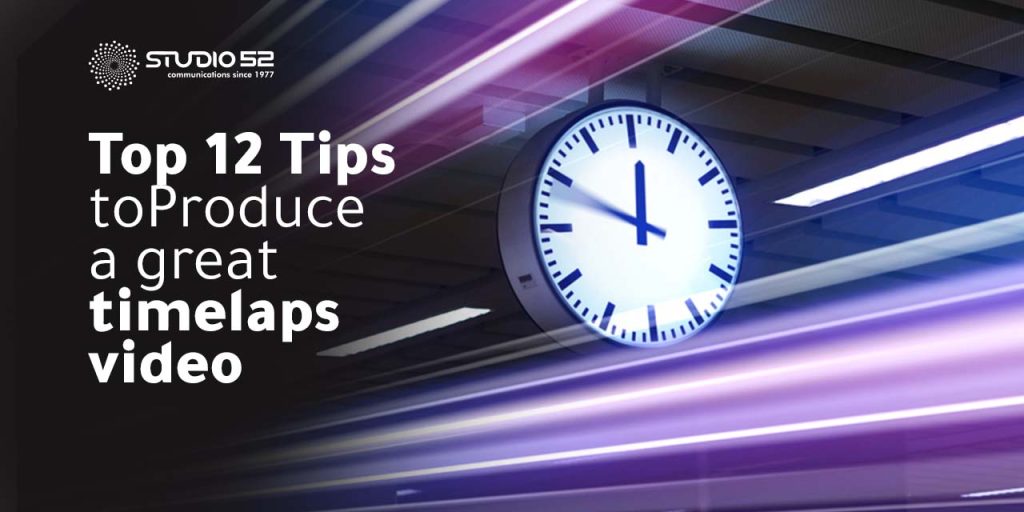Timelapse videography is a captivating technique that allows you to condense hours, days, or even months into a few mesmerizing minutes. Here at Studio52, we supply top companies with the best time lapse videos for their business, and today we share how you can make your time lapse videos better!
Join us as we delve into the artistry and technicalities of embracing timelapse videography, unveiling expert advice and insider tricks that will take your creations to new heights!
What Makes a Great Focus for TimeLapse
First thing first — what should you point your camera at?
In essence, we seek visual elements that illustrate the dynamic nature of our surroundings, indicating the passage of time. This encompasses various subjects that exhibit movement, such as clouds, the sun, the moon, stars, the ocean, fluctuating tides, bustling traffic, accumulating or melting snow, and blossoming flowers.
These subjects possess the capacity to transform and evolve over time, making them ideal for capturing captivating time-lapse footage. If your focus is a construction project, we are true pros when it comes to construction time lapse video service!
Furthermore, the composition is essential to consider when embarking on time-lapse photography.
Industrial TimeLapse Video Tips
Now onto the real juicy juice! How to make your time lapse videos great? There are more than a few factors involved, but we are sharing our favorites.
1. Load Your Batteries
We have all experienced it – before arriving at a shooting location, setting up everything meticulously, only to realize that the camera battery remains uncharged. To make matters worse, there are no spare batteries packed either. While DSLR camera batteries tend to offer considerable longevity on a full charge, mirrorless cameras are quite the opposite. Regardless of the camera type, you must ensure your battery is fully charged ahead of any shooting trip.
We always recommend carrying around three to four extras. Admittedly, they contribute some additional weight to the bag, but having the necessary power to keep the camera running is paramount. This principle applies not only to camera batteries but also to any external intervalometer, panning head, slider, or other batteries-reliant devices.
2. Use Backup
We acknowledge that only some possess two cameras, but for those who have upgraded their gear and retained their old camera as a backup, employing it for time-lapse photography can be a practical solution. Generally, the old camera will suffice for capturing captivating time lapse sequences. Nevertheless, it’s worth noting that shooting in challenging conditions, such as high ISO settings during nighttime, may reveal limitations in performance for certain older camera models.
An additional benefit of utilizing the backup camera is the preservation of the primary camera’s shutter. Time lapse shooting can rapidly accumulate shutter actuation, potentially affecting the longevity of the primary camera. By dedicating the backup camera specifically for time-lapse photography, you can minimize wear and tear on the primary camera’s shutter mechanism, potentially extending its lifespan.
3. Manual Mode To Avoid Flicker
Flicker poses a significant challenge in the realm of time lapse photography, capable of diminishing the quality of an otherwise outstanding video. Even slight variations in exposure between frames can contribute to this undesirable effect. However, there are strategies to mitigate flicker, and one effective approach is shooting in manual mode to maintain consistent exposure throughout the sequence.
Setting the shutter speed, aperture, and ISO values and keeping them unchanged can significantly reduce the likelihood of flicker. However, it is essential to note that this technique works best when there are no substantial shifts in the ambient lighting conditions, ensuring a smoother and more visually appealing time-lapse outcome.
4. Lock In Your Focus
Consistency in focus is as crucial as maintaining a steady exposure throughout your time lapse shooting sequence. To ensure a consistent focus, begin by selecting your desired focal point using either manual focus or auto-focus. Once you have achieved the desired focus, switch the camera and/or lens to manual focus mode.
To prevent accidental adjustments to the focus ring and maintain the chosen focus point, it is advisable to secure it with a piece of gaffer tape. This precautionary measure will help prevent any unwanted shifts in focus caused by accidental bumps or movements. By taking these steps, you can maintain a consistent focus throughout your time-lapse sequence, resulting in a visually pleasing and professional-looking video.
5. Shoot in Raw
The sheer number of images in time lapse videography may tempt you to opt for JPEG format to conserve memory space. While this approach may be suitable for certain scenarios, if you aim for quality time lapse, you should avoid it. Shooting in JPEG format means relinquishing control over image processing to the camera, discarding a significant amount of image data.
Shooting in RAW format is usually far more preferable. This is because RAW files provide far greater flexibility when processing images, allowing you to tailor them according to your preferences.
While concerns about hard drive space may arise, storage capacity is relatively inexpensive nowadays. That’s why the focus should primarily be on capturing the highest quality images rather than compromising quality for the sake of storage.
6. Add Some Motion
Although it may initially seem counterintuitive, taking your time-lapse photography to the next level involves introducing camera movement into the equation. While the camera remains stationary during a traditional time lapse, exploring the realm of camera movement can elevate your creations. Achieving this effect entails mounting the camera onto a motorized pan/tilt head and/or a slider. As the camera captures the image sequence, it simultaneously undergoes slow and controlled movements.
By incorporating camera movement into your time lapse workflow, you can add an element of dynamism and visual interest to your creations, taking them beyond the static shots and infusing them with a captivating sense of motion.

7. Secure Tripod
When preparing your equipment for time-lapse photography or videography, one crucial aspect deserves special attention: ensuring the camera remains securely stabilized. Even the slightest jolt or shake can be detrimental to the final outcome, potentially ruining the entire sequence.
To achieve optimal stability, it is imperative to not only lock down your tripod firmly but also implement additional measures. One effective method is to add extra weights to the tripod setup. This can be achieved by attaching your camera bag or utilizing sandbags secured with a carabiner. These added weights enhance stability by counteracting the influence of wind or any other potential movements that could compromise the steadiness of the camera.
8. Choose the Right Interval
Determining the appropriate time interval between shots is arguably the most critical factor in time lapse filmmaking, as it directly affects the speed and fluidity of the final video. An incorrect interval can result in a choppy and disjointed appearance, undermining the overall visual impact.
The chosen interval is contingent upon the specific movements of the captured subjects. Faster-moving elements typically require shorter intervals between shots, while slower-moving subjects can accommodate longer intervals, even spanning minutes or hours.
For instance, clouds exhibit a slow movement, making a 10-second interval between shots a practical choice. Conversely, capturing people walking down a street might necessitate a shorter interval of two seconds to maintain smooth motion. When recording a sunset or the passage of stars, a longer interval of around 30 seconds would be more suitable to convey the gradual changes in lighting or celestial movement.
9. Decide on the Length
Let’s say your end video will last 10 seconds; a simple method is calculating the number of photos required. First, multiply your desired frame rate, usually 24 frames per second, by 10.
For instance, shooting at 24 fps and aiming for a 10-second video would necessitate capturing 240 photos since 24 fps x 10 seconds = 240.
It is advisable to stick with this recommended number of photos unless you are uncertain about the appropriate interval for capturing your time-lapse. By shooting more photos than needed, you’ll always have ample material to work with in the editing process. Even if your original time lapse footage is 10 minutes long, speeding it up will condense it into a beautifully concise 10-second video.
Following this approach, you can capture enough frames to create the desired time lapse video length, regardless of the actual duration of the original footage.
10. Plan Your Logistics
An essential aspect of mastering time-lapse photography is learning the art of planning, which, surprisingly, many people tend to overlook. However, planning is a straightforward and immensely valuable step that can save you time and headaches in the long run.
To effectively plan your time lapse shoot, we recommend utilizing Google Maps. Begin by entering the address or general location of your desired shooting spot. Then, use the little yellow person icon in the image’s bottom right-hand corner. By dragging and dropping this icon onto the area you wish to view in street view, you can gain a visual understanding of the location and get a sense of what it will look like.
11. Arrive Early
In the realm of time lapse photography, punctuality holds significant importance. Therefore, arriving at your shooting location on time is crucial and even more beneficial if you don’t know the area.
Being punctual and prepared outweighs being slightly late and rushing to set up your shot. When you find yourself in a hurry, it becomes easier to make mistakes with unfortunate consequences, such as inadvertently knocking over your tripod, which can potentially damage your camera too!
12. Bonus Tip: Leave It to the Pros!
Creating a compelling time lapse video requires more than simply switching on your camera and starting to record. It involves carefully considering various factors, including selecting the ideal location, utilizing high-quality equipment and production techniques, and engaging the expertise of skilled voice-over and graphic professionals to bring it all together.
Therefore, it is highly recommended to opt for professional services when aiming to produce exceptional time lapse videos. By entrusting the task to professionals, you can rest assured that all aspects of the video production process are handled with precision and expertise, resulting in a final product that truly stands out from the crowd!
Studio 52 offers the best timelapse video service in Dubai and beyond, so if you want a time lapse worth sharing feel free to get in touch!
Conclusion
Producing a professional timelapse video requires a combination of artistry, technical know-how, and attention to detail. By following the tips outlined in this article, you will elevate your time lapse creations!
For professional-grade construction time lapse videos, it’s advisable to rely on the expertise of professionals. Their knowledge, equipment, and production techniques will ensure that your project stands out and leaves a lasting impression.
Studio 52 specializes in delivering top-notch Timelapse services, and you’re more than welcome to try us out!





